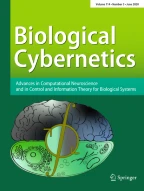Abstract.
To emulate the actual neuro-control mechanism of human bipedal locomotion, an anatomically and physiologically based neuro-musculo-skeletal model is developed. The human musculo-skeletal system is constructed as seven rigid links in a sagittal plane, with a total of nine principal muscles. The nervous system consists of an alpha motoneuron and proprioceptors such as a muscle spindle and a Golgi tendon organ for each muscle. At the motoneurons, feedback signals from the proprioceptors are integrated with the signal induced by foot–ground contact and input from the rhythm pattern generator; a muscle activation signal is produced accordingly. Weights of connection in the neural network are optimized using a genetic algorithm, thus maximizing walking distance and minimizing energy consumption. The generated walking pattern is in remarkably good agreement with that of actual human walking, indicating that the locomotory pattern could be generated automatically, according to the musculo-skeletal structures and the connections of the peripheral nervous system, particularly due to the reciprocal innervation in the muscle spindles. Using the proposed model, the flow of sensory-motor information during locomotion is estimated and a possible neuro-control mechanism is discussed.
Similar content being viewed by others
Author information
Authors and Affiliations
Additional information
Received: 03 December 1998 / Accepted in revised form: 09 June 2000
Rights and permissions
About this article
Cite this article
Ogihara, N., Yamazaki, N. Generation of human bipedal locomotion by a bio-mimetic neuro-musculo-skeletal model. Biol Cybern 84, 1–11 (2001). https://doi.org/10.1007/PL00007977
Issue Date:
DOI: https://doi.org/10.1007/PL00007977
